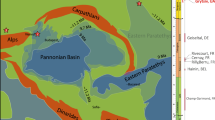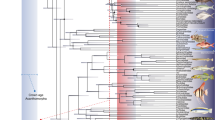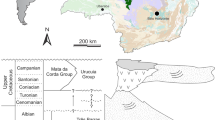Abstract
With ten extant families, salamanders (urodeles) are one of the three major groups of modern amphibians (lissamphibians)1,2,3,4,5,6. Extant salamanders are often used as a model system to assess fundamental issues of developmental, morphological and biogeographical evolution6,7,8,9,10,11. Unfortunately, our understanding of these issues has been hampered by the paucity of fossil evidence available to assess the early history of the group5,6,12. Here we report the discovery of an extraordinary sample of salamander fossils, some with rare soft-tissue impressions, from the Upper Jurassic of China13,14,15,16. With over 500 articulated specimens, this assemblage documents the morphological diversity of early urodeles and includes larvae and adults of both neotenic and metamorphosed taxa. Phylogenetic analysis confirms that these salamanders are primitive, and reveals that all basal salamander clades have Asian distributions. This is compelling evidence for an Asian origin of Recent salamanders, as well as for an extensive and early radiation of several major lineages. These discoveries show that the evolution of salamanders has involved phylogenetic and ecological diversification around a body plan that has remained fundamentally stable for over 150 million years.
This is a preview of subscription content, access via your institution
Access options
Subscribe to this journal
Receive 51 print issues and online access
$199.00 per year
only $3.90 per issue
Buy this article
- Purchase on Springer Link
- Instant access to full article PDF
Prices may be subject to local taxes which are calculated during checkout




Similar content being viewed by others
References
Milner, A. R. in Amphibian Biology (eds Heatwole, H. E. & Carroll, R. L.) 4, 1412–1444 (Surrey Beatty & Sons, Chipping Norton, Australia, 2000).
Trueb, L. & Cloutier, R. in Origins of the Higher Groups of Tetrapods: Controversy and Consensus (eds Schultze, H. -P. & Trueb, L.) 223–313 (Cornell Univ. Press, Ithaca, London, 1991).
Cannatella, D. C. & Hillis, D. M. Amphibian relationships: phylogenetic analysis of morphology and molecules. Herpetol. Monogr. 7, 1–7 (1993).
Feller, A. E. & Hedges, B. Molecular evidence for the early history of living amphibians. Mol. Phylogen. Evol. 9, 509–516 (1998).
Estes, R. Handbuch der Paläoherpetologie. Teil 2. Gymnophiona, Caudata (Gustav Fischer, Stuttgart, 1981).
Milner, A. R. in Evolution, Time and Space: the Emergence of the Biosphere (eds Sims, R. W., Price, J. H. & Whalley, P. E. S.) 431–468 (Academic, London, 1983).
Wake, D. B. & Larson, A. Multidimensional analysis of an evolving lineage. Science 238, 42–48 (1987).
Wilbur, H. M. & Collins, J. P. Ecological aspects of amphibian metamorphosis. Science 182, 1305–1314 (1973).
Shubin, N. & Wake, D. B. Phylogeny, variation, and morphological integration. Am. Zool. 36, 51–60 (1996).
Shubin, N., Wake, D. B. & Crawford, A. J. Morphological variation in the limbs of Taricha granulosa (Caudata: Salamandridae): evolutionary and phylogenetic implications. Evolution 49, 874–884 (1995).
Wake, D. B. Homoplasy: the result of natural selection or evidence design limitations? Am. Nat. 138, 543–567 (1991).
Evans, S. E. & Milner, A. R. A metamorphosed salamander from the Early Cretaceous of Las Hoyas, Spain. Phil. Trans. R. Soc. Lond. B 351, 627–646 (1996).
Luo, X. & Li, P. A study on the boundary age between Jurassic and Cretaceous. Acta Geos. Sinica 18, 242–247 (1997).
Ren, D., Yin, J. & Huang, B. Preliminary research on Late Mesozoic insect communities and ecostratigraphy of Fengning, Hebei Province. Geol. Sci. Tech. Inform. 18, 39–44 (1999).
Chen, P. Nonmarine Jurassic strata of China. Mus. North. Arizona Bull. 60, 395–412 (1996).
Wang, S. Correlation of the continental Jurassic in the north of China to the paralic Jurassic in northwest Scotland, United Kingdom. Acta Geol. Sinica 72, 11–21 (1998).
Gao, K., Cheng, Z. & Xu, X. First report of Mesozoic urodeles from China. Chin. Geol. 248, 40–41 (1998).
Dong, Z. & Wang, Y. A new urodele (Liaoxitriton zhongjiani gen. et sp. nov.) from the Early Cretaceous of western Liaoning Province, China. Vert. PalAsiat. 36, 159–172 (1998).
Wang, Y. A new salamander (Amphibia: Caudata) from the Early Cretaceous Jehol Biota. Vert. PalAsiat. 38, 100–103 (2000).
Duellman, W. E. & Trueb, L. Biology of Amphibians (McGraw-Hill Book Company, New York, 1986).
Larson, A. in Evolutionary Biology (eds Hecht, M. K., Wallace, B. & MacIntyre, R. J.) 25, 211–277 (Plenum, New York, 1991).
Larson, A. & Dimmick, W. W. in Amphibian relationships: Phylogenetic analysis of morphology and molecules. (eds Cannatella, D. & Hills, D.) Herpetol. Monogr. 7, 77–93 (1993).
Sever, D. M. Comparative anatomy and phylogeny of the cloacae of salamanders (Amphibia: Caudata). Herpetologica 47, 165–193 (1991).
Ivachnenko, M. F. Urodelans from the Triassic and Jurassic of Soviet Central Asia. Paleontol. J. 12, 362–368 (1978).
Evans, S. E., Milner, A. R. & Mussett, F. The earliest known salamanders (Amphibia: Caudata): a record from the Middle Jurassic of England. Geobios 21, 539–552 (1988).
Evans, S. E. & Milner, A. R. in In the Shadow of the Dinosaurs (eds Fraser, N. C. & Sues, H-D.) 303–321 (Cambridge Univ. Press, Cambridge, 1994).
Acknowledgements
We thank D. Wake and R. Carroll for discussion; K. Monoyios for editorial assistance; M. Ellison for illustrations; and A. Davidson for preparing GMV 1606. For help in field collection of specimens, we thank Z. Cheng, X. Xu, Y. Jin and Z. Chen. N.H.S. was supported by a grant from the John Simon Guggenheim Memorial Foundation. Field work was supported by the National Geographic Society and the Frick Funds of the American Museum of Natural History.
Author information
Authors and Affiliations
Corresponding author
Supplementary information
Supplementary Information
Supplementary Information
Rights and permissions
About this article
Cite this article
Gao, KQ., Shubin, N. Late Jurassic salamanders from northern China. Nature 410, 574–577 (2001). https://doi.org/10.1038/35069051
Received:
Accepted:
Issue Date:
DOI: https://doi.org/10.1038/35069051
This article is cited by
-
Study on the Jehol Biota: Recent advances and future prospects
Science China Earth Sciences (2020)
-
Adaptation to environmental change using reinforcement learning for robotic salamander
Intelligent Service Robotics (2019)
-
Cranial biomechanics in basal urodeles: the Siberian salamander (Salamandrella keyserlingii) and its evolutionary and developmental implications
Scientific Reports (2017)
-
From lamprey to salamander: an exploratory modeling study on the architecture of the spinal locomotor networks in the salamander
Biological Cybernetics (2013)
-
Where are we in understanding salamander locomotion: biological and robotic perspectives on kinematics
Biological Cybernetics (2013)
Comments
By submitting a comment you agree to abide by our Terms and Community Guidelines. If you find something abusive or that does not comply with our terms or guidelines please flag it as inappropriate.



